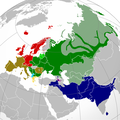Wêne:Indo-European branches map.png

Mezinahiya vê pêşdîtinê: 599 × 600 pîksel. Resolusyonên din: 240 × 240 pîksel | 479 × 480 pîksel | 767 × 768 pîksel | 1023 × 1024 pîksel | 2045 × 2048 pîksel | 2934 × 2938 pîksel.
Dosyeya orjînal (2934 × 2938 pixel, mezinbûnê data: 2,16 MB, MIME-typ: image/png)
Dîroka daneyê
Ji bo dîtina guhartoya wê demê bişkoka dîrokê bitikîne.
| Dîrok/Katjimêr | Wêneyê biçûk | Mezinahî | Bikarhêner | Şirove | |
|---|---|---|---|---|---|
| niha | 03:43, 26 îlon 2022 |  | 2934 x 2938 (2,16 MB) | Alexikoua | minor fixes |
| 15:58, 30 adar 2022 |  | 2934 x 2938 (1,74 MB) | Whoop whoop pull up | Whoops, wrong file! | |
| 15:37, 30 adar 2022 |  | 2048 x 2048 (980 KB) | Whoop whoop pull up | Misc fixes (Russian minority in Svalbard & Israel, Slovenian in SE Carinthia, Greek in N Epirus, Aromanians/Megleno-Romanians, Swedish essentially extinct in Estonia, etc. | |
| 09:37, 22 kanûna pêşîn 2021 |  | 2934 x 2938 (1,74 MB) | Ahmet Q. | Reverted to version as of 19:55, 23 August 2021 (UTC)seek consensus for your changes | |
| 20:40, 25 çiriya paşîn 2021 |  | 2934 x 2938 (2,16 MB) | Alexikoua | rv elimination of Greek minority in Albania | |
| 19:55, 23 tebax 2021 |  | 2934 x 2938 (1,74 MB) | Ahmet Q. | Rv false edit summary. Overrepresentation of Greeks in Turkey, Albania and Ukraine. Unexplained removal of Romanian in Serbia. Overall deterioration of the original file. Seek consensus for your changes. | |
| 16:16, 7 tebax 2021 |  | 2934 x 2938 (2,16 MB) | Demetrios1993 | Addition of Arbereshe linguistic minority in Sicily. Addition of Serbian, Bosnian, and Gorani linguistic minorities in Kosovo. Addition of Greek linguistic minorities in Italy, Albania, Turkey, and Ukraine. Including some other minor corrections. | |
| 17:00, 19 çiriya paşîn 2020 |  | 2934 x 2938 (1,74 MB) | Golden | update Armenian | |
| 18:42, 31 adar 2018 |  | 1479 x 1479 (574 KB) | Maphobbyist | Removed area that exactly corresponds to the non-Indo European Lezgi linguistic area. | |
| 21:37, 6 îlon 2016 |  | 1479 x 1479 (620 KB) | Rob984 | Georgia and Azerbaijan aren't majority multilingual. Older generations speak Russian from the Soviet era but now English is taught mainly in place of Russian. More people speak English in Finland, yet that isn't coloured. Also corrections to Celtic are... |
Bikaranîna pelê
Rûpelekî ku ji vê dosyeyê bi kar tîne nîne.
Bikaranîna gerdûnî ya pelê
Ev wîkiyên di rêzê de vê pelê bi kar tînin:
- Bikaranîna di ast.wikipedia.org de
- Bikaranîna di ban.wikipedia.org de
- Bikaranîna di be-tarask.wikipedia.org de
- Bikaranîna di be.wikipedia.org de
- Bikaranîna di bg.wikipedia.org de
- Bikaranîna di cs.wikipedia.org de
- Bikaranîna di da.wikipedia.org de
- Bikaranîna di de.wikipedia.org de
- Bikaranîna di en.wikipedia.org de
- Bikaranîna di en.wikiversity.org de
- Bikaranîna di es.wikipedia.org de
- Bikaranîna di et.wikipedia.org de
- Bikaranîna di eu.wikipedia.org de
- Bikaranîna di fa.wikipedia.org de
- Bikaranîna di fi.wikipedia.org de
- Bikaranîna di frr.wikipedia.org de
- Bikaranîna di fr.wikipedia.org de
- Bikaranîna di gl.wikipedia.org de
- Bikaranîna di gu.wikipedia.org de
- Bikaranîna di gv.wikipedia.org de
- Bikaranîna di hak.wikipedia.org de
- Bikaranîna di he.wikipedia.org de
- Bikaranîna di hy.wikipedia.org de
- Bikaranîna di hyw.wikipedia.org de
- Bikaranîna di ilo.wikipedia.org de
- Bikaranîna di incubator.wikimedia.org de
- Bikaranîna di io.wikipedia.org de
Zêdetir bikaranîna global a vê pelê bibîne.



